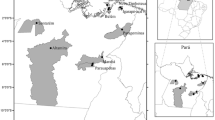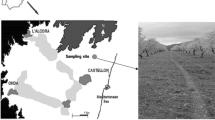Abstract
The sorption of phosphorus by solonchaks of the dry-steppe zone in the Republic of Buryatia from water solution of KN2PO4 in the concentration from 0.25 to 5.0 mM P/L was studied under static conditions. The interaction period was 24 hours, and the soil to solution ratio was 1 : 10. The amount of adsorbed phosphorus was calculated as the difference of its content in the initial solutions and in the filtrates of soil suspensions. Based on the experimental data, we constructed isotherms of phosphorus adsorption by soil and calculated sorption parameters using the Langmuir and Freundlich equations. Typical and quasigley solonchaks were characterized by relatively high phosphorus sorption properties. The maximal adsorption capacity (Amax) varied within 23.04–42.74 mM P/kg in the humus horizons of these soils and within 16.26–30.39 mM P/kg in deeper horizons. In general, the range of Amax was 17.70–42.74 mM P/kg in all soils, except for sor solonchak, where the sorption capacity of phosphorus was low. The Langmuir adsorption constant (KL) varied in the range of 0.3–14.0 L/mM. Dark and typical solonchaks were characterized by the strongest binding of phosphorus. The Freundlich coefficient (KF) in the studied soils varied from 5.34 to 63.43 mM P/kg in the humus horizon and from 1.74 to 22.68 mM P/kg in the underlying mineral horizons. The distribution coefficient (Kd) ranged within 1.95–145.04 L/kg and was high for quasigley solonchaks and low for sor solonchaks. There was a moderate correlation between Kd and Amax (r = 0.51) and high between Kd and KL (r = 0.84, p ≤ 0.05). According to the standardized phosphorus retention (SPR) (the amount of phosphorus that should be sorbed by the soil to maintain concentration of P = 0.2 mg/kg (0.0065 mM/L) in soil solution), the studied soils were assigned to the group with weak phosphorus sorption (SPR was from 0.0723 to 3.4836 mM/kg). According to the phosphorus sorption capacity, the soils were arranged into the following sequence: quasigley solonchak > typical solonchak > dark solonchak > gley solonchak > alluvial light-humus saline soil > sor solonchak.


Similar content being viewed by others
REFERENCES
N. E. Abasheeva, Soil Agrochemistry (Nauka: Sib. Izd. Firma, Novosibirsk, 1992) [in Russian].
Agrochemical Methods of Soil Research (Nauka, Moscow, 1975) [in Russian].
Z. S. Artem’eva, “Role of organic and organo-mineral components in the formation of the phosphate regime of arable horizons in erosion-degraded agro-sod-podzolic soils,” Byull. Pochv. Inst. im. V. V. Dokuchaeva 78, 70–86 (2015).
I. G. Vazhenin and E. A. Vazhenina, “Problem of phosphates in Transbaikalia,” in Proceedings of the Conference of Soil Scientists of Siberia and the Far East (Novosibirsk, 1964), pp. 433–441.
G. P. Gamzikov, Ts. D. Mangataev, and N. N. Pigareva, Fertility of Meadow-Chernozem Permafrost Soils (Nauka: Sib. Otd., Novosibirsk, 1991) [in Russian].
M. I. Gerasimova, I. I. Lebedeva, and N. B. Khitrov, “Soil horizon designation: state of the art, problems, and proposals,” Eurasian Soil Sci. 46 (5), 599–609 (2013). https://doi.org/10.1134/S1064229313050037
K. E. Ginzburg, Phosphorus in the Main Types of Soils of the USSR (Nauka, Moscow, 1981) [in Russian].
T. B. Diallo, Extended Abstract of Candidate’s Dissertation in Agriculture (St. Petersburg, 1993).
E. N. Efremov, Soil Fertility and Fertilizers. Electronic Resource. AgroXXI.ru https://doi.org/journal/199804/ 199804001.pdf. Cited February 2, 2023.
D. V. Karpova, N. P. Chizhikova, N. A. Kolobova, and V. V. Kononenko, “Analysis of the state of phosphorus in agro-gray soils of the Vladimir Opol’e,” Agrokhim. Vestn., No. 3, 15–19 (2016).
Classification and Diagnostics of Russian Soils (Oikumena, Smolensk, 2004) [in Russian].
V. S. Kursakova, “Effect of mineral fertilizers on the yield of perennial grasses under saline conditions,” Vestn. Altai. Gos. Agrar. Univ., No. 7, 45–51 (2019).
M. I. Makarov, “Phosphorus compounds in soil humic acids,” Pochvovedenie, No. 4, 458–466 (1997).
Ts. D. Mangataev, “Phosphate fund of automorphic soils of Western Transbaikalia,” Vestn. Sev.-Vost. Nauchn. Tsentra Dal’nevost. Otd. Ross. Akad. Nauk, No. 4, 79–83 (2006).
Ts. D. Mangataev, M. G. Merkusheva, and L. L. Ubugunov, “Content of phosphates in alluvial bog soils in the dry steppe zone of Transbaikalia,” Plodorodie, No. 3, 13–15 (2010).
Ts. D. Mangataev, N. A. P’yankova, and Yu. N. Ruzavin, “Phosphate content in virgin and arable soils of Western Transbaikalia,” Russ. Agric. Sci. 34 (4), 241–245 (2008).
M. G. Merkusheva and V. L. Ubugunov, “Estimation of the buffer capacity of soils in Transbaikalia for heavy metals,” in Soil Resistance to Natural and Anthropogenic Impacts (Moscow, 2002) [in Russian].
V. G. Mineev, Agrochemistry (Moscow, 1999) [in Russian].
National Strategy for Biodiversity Conservation in Russia (Moscow, 2012) [in Russian].
E. I. Pankova and A. F. Novikova, “Saline soils of Russia (diagnostics, geography, areas),” Pochvovedenie, No. 1, 73–83 (1995).
E. I. Pankova and I. N. Gorokhova, “Analysis of data on the area of saline soils in Russia at the end of the 20th and beginning of the 21st centuries,” Byull. Pochv. Inst. im. V. V. Dokuchaeva 103, 5–33 (2020). https://doi.org/10.19047/0136-1694-2020-103-5-33
Soil Science, Part 1: Soil and Soil Formation (Vysshaya Shkola, Moscow, 1988) [in Russian].
Methods for Increasing Soil Fertility (Liming, Phosphorite, Gypsum): Scientific and Methodological Recommendations (Rosinformagrotekh, Moscow, 2021) [in Russian].
Expanded Reproduction of Soil Fertility in Intensive Agriculture of the Non-Chernozem Region (VIUA, Moscow, 1993) [in Russian].
S. B. Sosorova, “Sorption of phosphate ion by alluvial soddy soil,” Nat. Inn. Asia, Nos. 2–3, 64–72 (2021).
S. B. Sosorova, “Sorption of phosphorus by soils of Western Transbaikalia,” Agrokhimiya, No. 3, 3–11 (2022).
S. B. Sosorova, M. G. Merkusheva, L. N. Boloneva, A. L. Baldanova, and L. L. Ubugunov, “Microelements in solonchaks of the western Trans-Baikal region,” Eurasian Soil Sci. 49 (4), 422–436 (2016). https://doi.org/10.1134/S106422931604013X
N. A. Toshmatova and L. D. Makarova, “The influence of phosphorus norms on the dynamics of its content in the soil and the yield of alfalfa under sulfate salinity,” Dokl. Timiryazevsk. S-kh. Akad., No. 3, 28–32 (2013).
L. L. Ubugunov, I. N. Lavrent’eva, and M. G. Merkusheva, “Biological productivity and humus status of soils of the Ivolginskaya depression (Western Transbaikalia),” Pochvovedenie, No. 5, 557–568 (2001).
L. L. Ubugunov, I. N. Lavrent’eva, V. I. Ubugunova, and M. G. Merkusheva, Soil Diversity in the Ivolginskaya Hollow: Ecological and Agrochemical Aspects (BGSKhA, Ulan-Ude, 2000) [in Russian].
L. L. Ubugunov, M. G. Merkusheva, and I. M. Andreeva, Sodium in the Ecosystems of Transbaikalia and Its Agrochemical Efficiency (Izd. Sib. Otd. Ross. Akad. Nauk, Novosibirsk, 2022) [in Russian].
L. L. Ubugunov, B. B. Ral’din, and V. I. Ubugunova, Soil Cover of Buryatia as a Basic Component of the Natural Resources of the Baikal Region (Izd. Buryat. Nauchn. Tsentra Sib. Otd. Ross. Akad. Nauk, Ulan-Ude, 2002) [in Russian].
L. L. Ubugunov, V. I. Ubugunova, and Ts. D. Mangataev, “Phosphate fund of the main types of alluvial soils of the Selenga River basin,” Pochvovedenie, No. 1, 67–73 (1998).
A. D. Fokin, Extended Abstract of Candidate’s Dissertation in Chemistry (Moscow, 1964).
M. A. Shumilova and V. G. Petrov, “Adsorption models of the behavior of pollutants in the soil of Udmurtia,” in Biodiagnostics of the State of Natural and Natural-Technogenic Systems. Proceedings of 19th All-Russian Scientific and Practical Conference (Kirov, 2021), pp. 130–134.
https://soil-db.ru/soilatlas/razdel-6-funkcii-pochv/ sorbcionnye-funkcii-pochv.
S. K. Asomaning, Processes and Factors Affecting Phosphorus Sorption in Soils (2020). //www.intechopen. com/chapters/70866. https://doi.org/10.5772/intechopen.90719
R. Beji, W. Hamdi, A. Kesraoui, and M. Seffen, “Effects of salts on phosphorus adsorption in alkalize Tunisian soil,” Euro-Mediterr. J. Environ. Integr. 2, 2 (2017).
M. D. Bolland, D. G. Allen, and N. J. Barrow, Sorption of Phosphorus by Soils: How It Is Measured in Western Australia (Department of Primary Industries and Regional Development, Western Australia, Perth. Bulletin, 2003).
K. Börling, Doctoral thesis (Swed. Univ. Agric. Sci., Uppsala, 2003).
I. C. Cantrell and R. G. Linderman, “Preinoculation of lettuce and onion with VA mycorrhizal fungi reduces deleterious effects of soil salinity,” Plant Soil 233, 269–281 (2001).
E. H. Chaudhary, A. M. Ranjha, M. A. Gill, and S. M. Mehdi, “Phosphorus requirement of maize in relation to soil characteristics,” Int. J. Agric. Biol., No. 5, 625–629 (2003).
A. Chimdi, H. Gebrekidan, A. Tadesse, and K. Kibret, “Phosphorus sorption patterns of soils from different land use systems of East Wollega. Ethiopia,” Am.-Eurasian J. Sci. Res. 8, 109–116 (2003). https://doi.org/10.5829/idosi.aejsr.2013.8.3.12056
D. E. Dodor and K. Oya, “Phosphate sorption characteristics of major soils in Okinawa. Japan,” Commun. Soil Sci. Plant Anal. 31, 277–288 (2000). https://www. researchgate.net/publication/249073919_Phosphate_ sorption_characteristics_of_major_soils_in_Okinawa_ Japan.
Z. Ding, A. M. S. Kheir, M. G. M. Ali, O. A. M. Ali, A. I. N. Abdelaal, X. Lin, Z. Zhou, B. Wang, B. Liu, and Z. He, “The integrated effect of salinity. organic amendments. phosphorus fertilizers. and deficit irrigation on soil properties. phosphorus fractionation and wheat productivity,” Sci. Rep. 10, 2736 (2020). https://doi.org/10.1038/s41598-020-59650-8
N. K. Fageria and A. Moreira, “The role of mineral nutrition on root growth of crop plants,” Adv. Agron. 110, 251–331 (2011).
N. Gaurina-Medjimurec, Handbook of Research on Advancements in Environmental Engineering (IGI Global, 2014).
S. Gonzalez-Rodriguez and M. L. Fernandez-Marcos, “Phosphate sorption and desorption by two contrasting volcanic soils of equatorial Africa,” Peer J 6, e5820 (2018). https://doi.org/10.7717/peerj.5820
S. R. Grattan and C. M. Grieve, “Salinity–mineral nutrient relations in horticultural crops,” Sci. Hortic. 78, 127–157 (1998).
M. Gregor, “Mullite-corundum-spinel-cordierite-plagioclase xenoliths in the Skaergaard Marginal Border Group: multi-stage interaction between metasediments and basaltic magma,” Contrib. Mineral. Petrol., No. 49, 96–215 (2005).
P. Sanchez and U. Goro, The Role of Phosphorus in Agriculture. Symposium Proceeding (ASA, CSSA, SSSA, Madison, 1980), pp. 471–514.
S. Sato and N. B. Comerford, “Influence of soil pH on inorganic phosphorus sorption and desorption in a humid Brazilian Ultisol,” Rev. Bras. Ciênc. Solo, No. 29, 685–694 (2005).
R. A. Scherrer and S. M. Howard, “The use of distribution coefficients in quantitative structure-activity relationships,” J. Med. Chem. 20, 53–58 (1977). https://doi.org/10.1021/jm00211a010
R. Uddin, P. A. Baloch, S. Iqbal, M. A. Bhutto, F. K. Nizamani, A. H. Solangi, and A. A. Sidiqui, “Phosphorus sorption characteristics of four soil series,” J. Anim. Plant Sci. 24, 1547–1553 (2014).
Y. T. Wang, I. P. O' Halloran, T. Q. Zhang, Q. C. Hu, and C. S. Tan, Phosphorus Sorption Parameters of Soils and Their Relationships with Soil Test Phosphorus https://doi.org/10.2136/sssaj2014.07.0307
Z. Wolde and W. Hai, “Phosphorus sorption Isotherms and External phosphorus requirements of some Soils of southern Ethiopia,” Afr. Crop Sci. J. 23, 89–99 (2015). https://www.researchgate.net/publication/277834837_ phosphorus_sorption_isotherms_and_external_phosphorus_requirements_of_some_soils_of_southern_ethiopia.
Funding
This work was performed within the framework of state assignment no. 0271-2021-0004.
Author information
Authors and Affiliations
Corresponding author
Ethics declarations
The authors declare that they have no conflicts of interest.
Additional information
Translated by I. Bel’chenko
Rights and permissions
About this article
Cite this article
Sosorova, S.B., Merkusheva, M.G., Boloneva, L.N. et al. Phosphorus Sorption by Saline Soils of Western Transbaikalia. Eurasian Soil Sc. 56, 1394–1406 (2023). https://doi.org/10.1134/S1064229323601361
Received:
Revised:
Accepted:
Published:
Issue Date:
DOI: https://doi.org/10.1134/S1064229323601361




